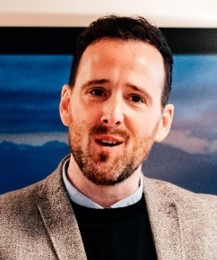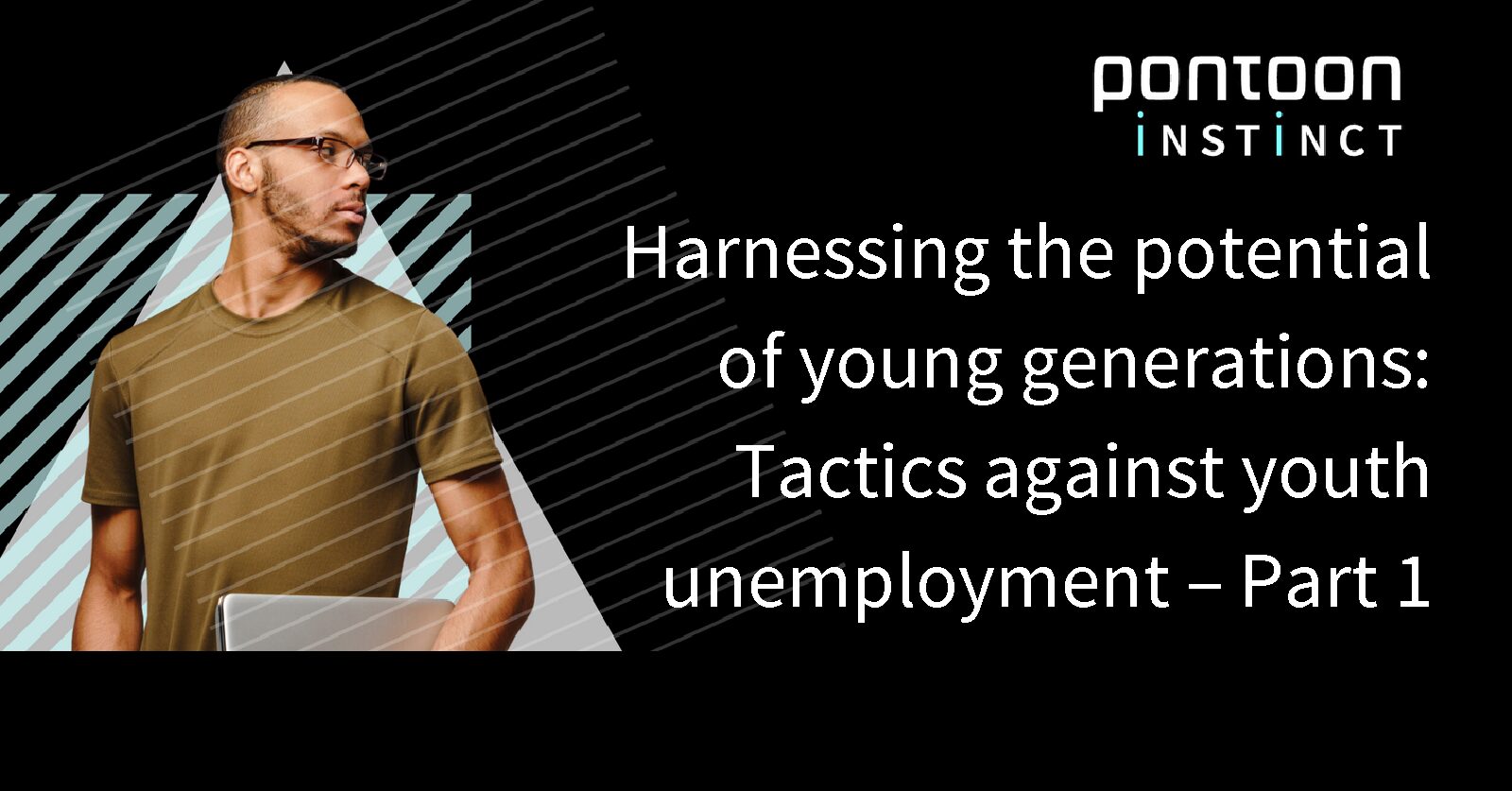Harnessing the potential of young generations: Tactics for supporting youth in the workplace – Part 2
Video
.
The International Youth Day, which we observe on August 12th each year, is a moment to recognise the power of young individuals in reimagining the future world, including the workplace.
Our Pontoon Instinct Director of Strategic Insights – Shannon Robertson – recently interviewed Adecco Group’s (TAG) Global Head of CEO for One Month – Dan Crerand – on how businesses can get involved in realising the potential of young people worldwide. In part one, Shannon and Dan focused on ways companies can help fight youth unemployment. Tune in to part two of this important conversation that touches upon helping to maximise the young generation’s talents at work.
CEO for One Month is TAG’s initiative that allows young people to develop and showcase their potential in a real-life corporate environment. Led by Dan, this unique internship lets youth acquire the skills and experience needed to get a foot on the career ladder. Notably, the scheme requires no specific education or skill background. Instead, it focuses on the person’s potential to develop into a future business leader.

Shannon Robertson – Strategic Insights Director, Pontoon Instinct
Shannon Robertson: This new analysis of labour market data shows that the number of NEET (not in education, employment or training) youth reporting mental health problems has increased from 11% in 2011 to 30% in 2022. Do you think businesses should be developing strategies to support young people entering the job market who identify with a mental health condition?

Dan Crerand – Global Head of CEO for One Month, TAG
Dan Crerand: Great question. I’m no expert in this field, but I’ll give my thoughts from a personal perspective. I didn’t know those exact figures you just shared with me, but it doesn’t surprise me. This is a population of people who might be moving cities and countries, sitting in their first face-to-face role in an office, daunted by lots of new experiences, especially those people who finished their education in a virtual environment.
Before I answer, I must say that I’m a glass-is-half-full guy in many respects. The talent I’ve worked with post-pandemic, I’ve seen such a noticeable difference. In the past, I’ve seen interns and grads sit on problems. They felt like they couldn’t share something with their manager, maybe because they thought that would go against their chance of getting a permanent role or a position in the graduate programme – so instead, they sat there, and the problems escalated.
Whereas now, fast forward to 2023, I have the luxury of working with these fantastic individuals. The talent I speak to, they’re open; they are not afraid to show and trust you with their vulnerabilities. If their workload is too much, they’re more likely to raise it. So, I think those numbers can go either way. Maybe it’s even the transparency of some managers and senior leaders, businesses leading with authenticity, encouraging people to forget about perfectionism. I need to do that myself – I was always too keen to be a perfectionist. Maybe it also has to do with businesses being more committed to mental health and wellbeing, raising these numbers because of the awareness piece.
But yeah, of course, we do need to look at it in terms of the transfer to virtual environments. I think one way I always describe this is – in the past if I knew one of my team was having a bad day, I would probably find out from looking across the desk or as they grabbed a coffee or if they disappeared. Those opportunities are less frequent now.
Many young talents I’m speaking to are worried about the potential impact on their career, pay, AI progression, and post-pandemic transition. One thing I found really helpful from work for my clients in the intern space was a wellbeing and engagement manager role. It gave us this new outlook – somebody who was detached from the standard hiring manager decision-maker space; someone that gave us this middle ground between both parties. The intern could speak to them about themselves and their personal circumstances without concern about a link to performance management, etc. They would run wellbeing events, would have a virtual open door etc. It was just about opening these opportunities to allow people to speak, and we got some really, really great feedback from it.
Shannon Robertson: The research shows how far opportunities are still determined by background and predicts a fall in income mobility for young people. This is driven particularly by the pandemic and impacts especially those children who lost out on hours of school learning during lockdown. Are there other actionable insights that companies can incorporate to promote or drive social mobility in their organisations?
Dan Crerand: Yes, it’s very important for me personally, as I got the chance to run my own global programme that is as inclusive as possible in terms of no educational or skill set parameters.
But as businesses, we all know what’s on the agenda – we’ve got to lead from the front. It will take time to make your own business story, articulate your value commitments and why you want to be driving these social improvements and make them practical and realistic in terms of the adjustments. It’s not going to happen overnight; there are challenges. I think that’s where people try to look for the showstoppers when the practical and realistic solutions are probably better.
There’s such an opportunity to get out there. I spoke to a few universities last year, and they are hearing these stories about companies wanting to be better around social purpose. These institutions have a higher proportion of students from low to medium socioeconomic backgrounds regarding financials, health, social resources, etc. and they were so disappointed that companies make these social commitments but don’t connect with education bodies to realise them in action. They weren’t seeing the big players coming from the outside with face-to-face or virtual support. There’s an opportunity for us to remedy that, especially that we are in a really luxurious position here, being in the HR recruitment field. We have so much to offer; we know what good looks like, and what it takes to get that job. We have such a powerful position to help, and as organisations we can do more of that.
In terms of logistics and little things, I’d say the key is to openly advertise, outside of the standard routes where possible. If your organisation is super diverse and you’re really pleased with what you’re doing, share that. Make sure interviewing panels are fair and diverse. The same applies to your websites and your social media – make sure you paint a fair picture on these channels because sometimes young talent will look at a website and they will say: “You know what, I’m not dressed like them or I’m not as confident or they speak differently than me”. And their self-opting out of processes is the biggest no-no in this situation. That’s where it’s all going wrong.
In terms of processes, just try and give as many layers to the process as possible in terms of opportunities to interact and integrate with your candidates. Remember, it’s not just about us selecting them. It’s about us allowing them to select us. It’s not always one way nowadays, and recruitment is about both ways.
I think the upskilling opportunities are quite a big one also. If you compare organisations, and investments into postgraduates versus school leavers, there is a huge difference in terms of who gets offered the upskilling, which to me is again the wrong way around. Upskilling should be offered to people irrelevant of their educational background.
And then lastly, with all these requirements, just never forget it’s one thing to get these high-potential people into your business, but that needs to continue. Too often, I would see it where we spent a lot of money on attraction, and then they come into your business and are left to themselves. They need to feel welcome to be their true self in the organisation, and then they are more likely to stay.
Get in touch with us through the button below to see how we can help you drive systemic changes to young talent employability with Pontoon Instinct.
Related Post
August 12th marks the International Youth Day, where we celebrate the potential of young people to shape the future of our increasingly interconnected world. With half of the global population ...




